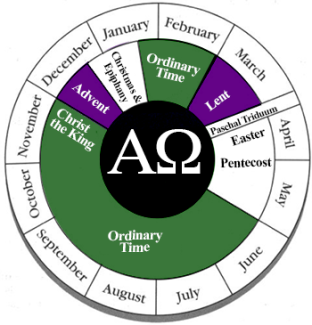
The here-and-now is no mere filling of time, but a filling of time with God.
I work in the tech industry on a virtual business team. We have people located across the country from Virginia to Hawaii and many places in between. The team is run by the calendar. It’s difficult scheduling conference calls with a team spread across five time zones, so we have to schedule carefully and stick closely to the schedule.
Personally, I would be pretty lost without the Microsoft Outlook calendar on my laptop. Between my work, volunteering, doctor appointments, shuttling grand kids around, birthday reminders, weddings, funerals and the like I simply couldn’t keep track of where to be when without a calendar.
While most adults in the Western World are familiar with calendars, there is one calendar that’s terribly overlooked in many circles. I’m speaking about the Christian liturgical calendar. The liturgical year (or Church year) is a continuous cycle of Christian seasons that include various feast days that mark celebrations of the Church. The liturgical year also has a set list of readings for every day of the year. Observing the liturgical calendar is highly enriching, providing a continuous commemoration of key events in the life of Christ and the church. Sadly, many Christian denominations hardly recognize the liturgical calendar at all.
According to the website The Voice, “The Christian calendar is organized around two major centers of Sacred Time: Advent, Christmas, and Epiphany; and Lent, Holy Week, and Easter, concluding at Pentecost. The rest of the year following Pentecost is known as Ordinary Time, from the word “ordinal,” which simply means counted time (First Sunday after Pentecost, etc.) (http://www.crivoice.org/chyear.html).

Let’s take a short tour of the Church liturgical year. It begins with Advent, which occurs in December. Advent commemorates Israel’s wait for the birth of the Messiah, which was promised in prophecy. For modern Christians, it is symbolic of our waiting for Christ to “come again in glory to judge the living and the dead,” as many Christians frequently recite in the words of the Nicene Creed.
Advent is followed by Christmas on December 25, and Epiphany in January. Christmas is the celebration of the birth of Jesus Christ, Israel’s promised Messiah and God’s only begotten son–the savior of the world. It is followed by Epiphany, which is translated “appearance.” Epiphany commemorates the visit by the Magi (or three wise men) to baby Jesus, when they reveal that Jesus is the Messiah and bring him gifts of gold, frankincense and myrrh. Gold represents the kingship of Jesus. Frankincense, which is sweet incense, represents His earthly priesthood. Myrrh, a sweet spice used in preparing bodies for burial, represents Jesus’ coming crucifixion and death on the cross for the forgiveness of the sins of the world. The later part of January and the month of February are ordinary time on the liturgical calendar.
Lent, Easter and Pentecost follow the ordinary time in February. Lent is the period of 40 days from Ash Wednesday to Easter Sunday, commemorating Christ’s final journey to Jerusalem, where he will be crucified. It is a period of penitence and alms giving for the church. On Ash Wednesday, many Christians have their foreheads marked with ashes in the sign of the cross.
Palm Sunday occurs the Sunday before Easter. It commemorates Jesus’ Triumphal Entry into Jerusalem and his final journey to the cross. He rode into the city on a donkey while the crowds shouted “Hosanna,” which is translated “save us,” and they laid palm leaves in his path. Modern day Christians often celebrate Palm Sunday by waving palm leaves during a processional at the beginning of their church service. Palm leaves from the Palm Sunday service are burned and the ashes collected to be used during Ash Wednesday of the following year.
At the end of Lent comes a period of three days called the Paschal Triduum, which begins on Maundy Thursday, proceeds through Good Friday, and ends with a liturgy on the evening of Easter Sunday. These all fall inside Holy Week, the week ending with Easter.
Maundy Thursday marks the night before Christ’s crucifixion, when he celebrates the Last Supper with his disciples, giving us the gift of the Holy Eucharist. Good Friday commemorates the crucifixion of Christ for the forgiveness of our sins and his burial. Easter celebrates Christ’s glorious resurrection and his victory over sin and death. Christ taught his disciples for 40 days following the resurrection, then he miraculously allowed them to see his Ascension into heaven, which occurred before their eyes; meanwhile, angels promised the disciples that just as they saw him ascend into heaven, they will also him descend back to the Earth to reign in glory forever.
Following the Ascension comes Pentecost. Pentecost commemorates God’s gift of the Holy Spirit to his disciples and marks the beginning of the Church. Following the season of Pentecost, the months of June through November are ordinary time on the liturgical calendar. At the end of November, on the Sunday before Advent begins, we celebrate Christ the King Sunday, a day reminding Christians that they owe their first allegiance to Christ, not earthly powers or rulers.
So there you have it. Observing the Church liturgical calendar is a beautiful way of celebrating Christ’s birth, crucifixion, resurrection and the establishment of Christ’s Church on Earth. If your personal tradition doesn’t observe the liturgical calendar, consider adopting it to add a new level of richness to your worship. In doing so you you’ll find inspiration and hope.
Recent Comments